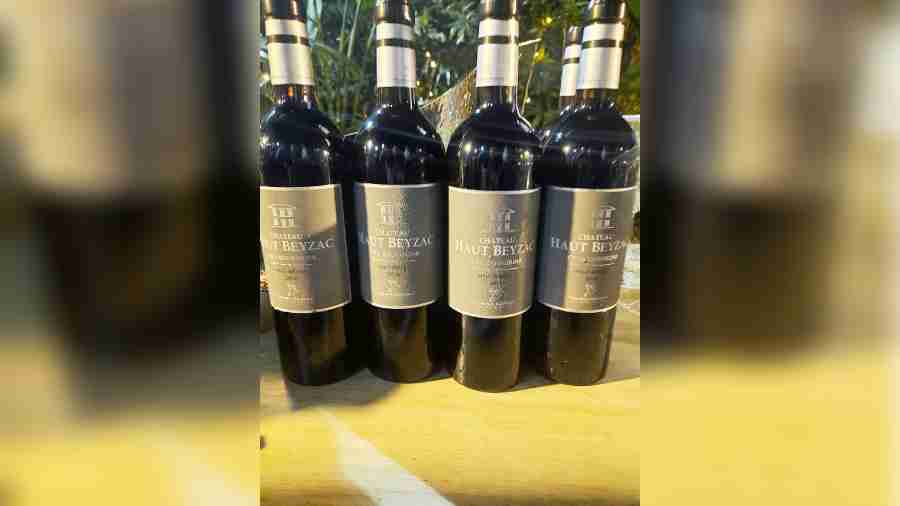A recently held winetasting soiree hosted by Didier Talpain, consul general of France in Calcutta, saw the launch of three French wines from the Bordeaux region. They included two entry-level wines, a white and a red, along with a Cru Bourgeois red, Château Haut Beyzac.
The two entry-level wines, B from Bordeaux, are simple, easy-drinking wines. The white is predominantly Sauvignon Blanc with notes of freshly cut grass and capsicum and excellent acidity. The red is a blend of Merlot, Cabernet Sauvignon and Petit Verdot, very fruity with good acidity and pleasing mouthfeel. Both these wines are ideal for parties where you don’t have to think too much about the wine and continue with your socialising and networking.
The third wine to be launched during the evening was Château Haut Beyzac, a Cru Bourgeois from Haut Medoc. Elegant and well-structured, the wine has many qualities. But before I delve into the qualitative aspects of the particular wine it is important to understand the classification of Cru Bourgeois.
Wine politics
Never to be despised, Cru Bourgeois is a list of wines that in terms of quality are considered at a level below the Cru Classé list and offers wine lovers excellent quality and diverse style at affordable prices. To really understand Cru Bourgeois we need to go back in history. Cru Bourgeois comes from the Left Bank of Bordeaux within eight appellations of the appellation of Medoc. The eight communes are Saint Estephe, Paulliac, SaintJulien, Margaux, Listrac, Moulis, Haut Medoc and Medoc.
After the Medoc classification of 1855, many smaller chateaux were disappointed at being left out. Not to be outdone, a classification of the smaller chateaux was made in 1858, but it was not until 1932 that a formal list was drawn up by the Bordeaux Chamber of Commerce consisting of 444 chateaux. Because since this classification was never ratified, unlike the Medoc classification of 1855, many revisions have taken place, each time riddled with dissatisfaction, angst and politics.
A major revision of the classification was initiated in 2000, which divided it into three tiers and reduced the number of chateaux from 444 to 247. This caused a huge furore among the chateau owners, so much so that after much legal wrangling the 2003 classification had to be annulled by the French court and the use of the term banned.
In 2010, the Cru Bourgeois label was reintroduced in a revised form with only one level to create a new certification Label Cru Bourgeois, not as a classification but as a mark of quality across all wines of Medoc. This, too, met with strong resentment, specially with chateaux which were at the top tier of the earlier classification. Many pulled out and decided to remain outside the classification. Their rationale was perfectly understandable. Why would they be in the same group as others who sold their wine at a considerably lower price? Instead, they formed their own group. After all, this classification did not offer different levels of quality.
In 2020, the Alliance des Crus Bourgeois du Medoc announced the new Cru Bourgeois classification starting with the 2018 vintage. It lists 179 Crus Bourgeois, 56 Crus Bourgeois Superieurs, and 14 Crus Bourgeois Exceptionnels, a total of 249 châteaux. This classification will remain for five years and the next classification to be done in 2022 will start with the 2023 vintage.
In my opinion, this is a step in the right direction as it will help build the image of Cru Bourgeois, improve the quality of wine and help market French wines in the export market. For consumers in India, it will increase awareness, gain wider acceptance and improve knowledge about the taste of different cru bourgeois as more and more Cru Bourgeois will hit the Indian market.
Wine style
With such a large and diverse number of chateaux, Crus Bourgeois offers value, character and style at an affordable price. For those of us uninitiated to higher-classed wines, Cru Bourgeois is an excellent entry point to start cultivating your love for Bordeaux.
The greatness of Bordeaux is its assemblage, the freedom to blend wines from different grapes to make the final product. For wines of the Left Bank, the predominant grape would be Cabernet Sauvignon, followed by Merlot, Cabernet Franc and Petit Verdot. A small quantity of Malbec, as well as Carmenere may also be used. However, in reality, many Cru Bourgeois use a higher percentage of Merlot in the blend.
The reasons are that Merlot is an earlier-ripening grape and insures the winery against hail and rain during normal harvest. The other reason is that Merlot is far more approachable than Cabernet Sauvignon. With consumers drinking far younger wines than ever before, especially in India, higher percentage of Merlot in the blend makes the wine far more acceptable in its youth.
At their best, Cru Bourgeois can match some of the more expensive classed growth of Bordeaux, but many can be rustic, especially in a hard vintage when grapes don’t fully ripen. Most Cru Bourgeois are meant to be drunk young, within 10 years of the vintage. There are, however, several Cru Bourgeois chateaux making wines of exceptional quality that will age beautifully and develop complexities which connoisseurs the world over love. These estates are usually located on better ground in the major appellations and use a higher percentage of Cabernet Sauvignon in the blend.
Today, the 249 chateaux account for 31 per cent of the Medoc production making 28 million bottles of the 2018 vintage. Personally, I think that the quality has never been better and with most estates investing in new equipment and technology in wine-making, quality will improve further. Add to that they remain affordable in terms of price-to quality ratio.
Now coming back to Chateau Haut Beyzac 2018. The wine was introduced by its owner MariePierre Lalllez. The chateau is located in Haut Medoc near the commune of Saint Estephe. It covers an area of eight hectares producing around 40,000 bottles. The wine is a blend of 65 per cent Merlot, 30 per cent Cabernet Sauvignon and 5 per cent Petit Verdot. The Petit Verdot adds a different dimension to the winemaking, adding colour and tannins to the wine but with such a small quantity it is not likely to have any significant bearing on the final outcome.
What is right about the wine? The wine has notes of lovely dark fruits, good acidity and very soft, evolved tannins. The palate is lush with notes of coffee, dark chocolate and cinnamon. It is a mediumbodied wine that is elegant and well-structured. Personally, I liked the wine as the higher amount of Merlot makes the wine more approachable and at five years it is drinking beautifully.
It is very well suited to Indian palates and will match with most Indian dishes, both in curries and in kebabs. The key to the wine’s success in the Calcutta market will depend on the price adopted by the importers.
The author is a wine connoisseur






